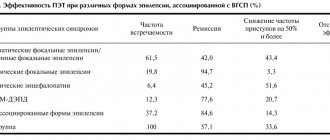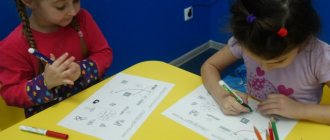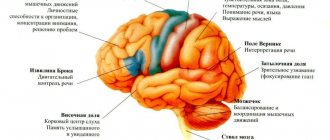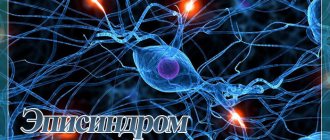Epilepsy is a chronic heterogeneous brain disease that manifests itself as spontaneous epileptic seizures. This condition is considered to be the clinical equivalent of hypersynchronized discharges in neurons. The first mentions of epilepsy are found in the chronicles of Ancient Babylon. In the Middle Ages, it was believed that such patients were possessed by evil spirits, and only at the end of the twentieth century was it possible to establish the true cause of the terrifying symptoms.
Epilepsy is one of the most common paroxysmal pathologies, which is manifested by episodes of impaired control over consciousness and motor activity. In more than 50% of all patients, the disease manifests itself in childhood, so studying this issue in pediatrics remains relevant.
The prevalence of epilepsy in developed countries is 5–10 cases per 1000 people. According to other sources, the incidence of this nosology in the general population reaches 2%, half of which are patients under 18 years of age. In Ukraine, the incidence of epilepsy is 4.5–5.9 per 1000 people. The difficulty of statistical calculation lies in the fact that there are many variants of paroxysmal central nervous system disorder, which are not always taken into account by experts.
Childhood epilepsy is becoming more common every year: the frequency of new diagnosed cases in the general population is 0.2 per 1000 people, in childhood - 0.9 per 1000 people. The disease is characterized by neurobiological, cognitive, psychological and social consequences. Timely diagnosis and adherence to lifelong drug treatment eliminates these complications.
Epilepsy in children
Epilepsy is one of the most common neurological diseases in the world. People of all ages are susceptible to it, but in children various epileptic manifestations are three times more common. The first epileptic seizure occurs in 78% of children.
There are about 60 types of epilepsy. A child diagnosed with epilepsy may be no different from his peers, not have any seizures, play and develop according to his age. But it’s bad to study at school because he “stares” at one point for 15 seconds and misses information in class (absences). Or an infant with West syndrome with seizures that are difficult to distinguish from the normal motor activity of a newborn.
Such convulsions can be repeated up to 100 times a day, and each time the electrical discharge will destroy the baby’s developing brain. Although outwardly these seizures do not seem to be anything serious, the child simply spreads his arms to the sides. Such a child does not develop and cannot even hold his head up. This leads to lifelong disability of the baby with subsequent death. Therefore, it is incorrect to talk about epilepsy as one disease, and approaches to its treatment will be different.
Diagnosis of epilepsy
Epilepsy is diagnosed using an EEG (Electroencephalogram), the picture shows jumps in Theta waves and dysrhythmia. An experienced neurologist-epileptologist should decipher the EEG. The gold standard in epileptology is nightly 12-hour video monitoring of a child’s sleep.
Only in this case is it possible to determine with 90% certainty the nature of the attack, the area of distribution of the discharge, and its presence in principle. During a daily routine EEG, in half an hour the presence of epilepsy can be detected only in 30% of cases, and even less if the diagnosis is carried out on an infant.
If epileptic activity is detected in children, the doctor prescribes an MRI of the brain. Magnetic resonance imaging will help determine whether the child has organic brain lesions, tumors, cysts and other anomalies that generate an electrical discharge.
It is also necessary to conduct a blood test for deficiencies of microelements and vitamins (especially magnesium, zinc, omega-3). The relationship between vitamin deficiency and epileptic seizures in children has been clinically proven.
Causes of epilepsy
In 60% of cases, people suffering from epilepsy or parents of sick children never receive an answer to the question of why the attack occurred. In such cases, epilepsy is diagnosed as “idiopathic” or “cryptogenic”, that is, the cause of the disease is unknown.
If the cause of epilepsy is identified, it is classified as secondary (symptomatic) epilepsy. Seizures can be stopped by eliminating the root cause. Causes of secondary epilepsy include:
- Genetic predisposition to epilepsy
- Organic brain damage in the prenatal, natal period: hypoxia, fetal asphyxia (critical lack of oxygen), severe prematurity
- Aggravated obstetric history: trauma during childbirth - the child gets stuck in the birth canal; if labor is weak, stimulants, epidural anesthesia, forceps, vacuum are used, which is also a risk factor for the newborn.
- Congenital abnormalities of brain development (hydrocephalus, microcephaly, genetic malformations, etc.)
- An infectious disease suffered by the mother, contact with a sick child (whooping cough, rubella, cytomegalovirus, Zikka virus, etc.)
- An infectious disease suffered by a child, with complications in the form of meningitis, encephalitis, neurocysticercosis.
- Malignant and benign neoplasms in the brain (cysts, hematomas, cancerous tumors)
- Congenital metabolic diseases (metabolic disorders)
- External factors - complications after vaccination, toxic shock
- In 60% of cases, the cause remains unclear (idiopathic form)
Causes of the disease
Possible causes of epilepsy include the following:
- genetic predisposition inherited from parents;
- infectious diseases of the brain;
- traumatic brain injuries;
- viral diseases affecting the brain;
- Down syndrome;
- congenital defects of brain structure;
- chronic diseases of the central nervous system.
The causes of the disease are determined during an examination of the body. Each case is individual and requires a professional approach. Manifestations of the disease can be varied, so it is necessary to take into account any deviations from the norm of the child’s behavior, viral diseases he has suffered, and hereditary factors.
Symptoms and signs of epilepsy
Epilepsy is classified according to the location of the electrical discharge. This may be a separate area in the brain, or the discharge covers two hemispheres at once (generalized seizures).
? When the entire brain is involved at once, it is customary to speak of primary generalized seizures:
- Tonic-clonic seizures. This is epilepsy in its “classical” presentation: seizures with loss of consciousness, switching off, falling, convulsions, rolling out eyes, biting the tongue, etc. A person suffering from epilepsy, after a generalized attack, does not remember what is happening and feels very tired and can fall asleep.
- Absence seizures. Short blackouts of consciousness for 10 seconds to 2 minutes without convulsions. After an attack, the condition remains unchanged; absence seizures are often mistaken for the child’s absent-mindedness.
? When nerve cells are damaged in one area, the seizure focus is located in one zone, but then it can spread to both hemispheres.
These are focal (partial) seizures of epilepsy. They are the most common among all cases of epilepsy and are divided into:
Simple - attacks without switching off or changing consciousness. Manifestations of simple focal epileptic seizures are different:
- motor signs: twitching, tics, involuntary movements in one part of the body, “marching”, other uncontrolled body movements and facial expressions
- changes in sensory perception: hallucinations, seemingly foreign sounds, strange taste in the mouth, dizziness
- sweating, redness of the face, changes in pupils
- vocalizations: the person may shout different words uncontrollably
Complex - consciousness changes or turns off, a person may not remember what happened. Complex focal seizures of epilepsy can develop into generalized ones.
They are characterized by altered behavior:
- motor automatisms
- motor disorders
- disturbances of consciousness
- complex hallucinations
- anger, phobias
- dementia (a state of deja vu, an event already seen or experienced), etc.
? Secondary generalized epileptic seizures begin in one area and subsequently spread to both hemispheres. They begin in the form of convulsions or disturbances of consciousness and turn into a severe epileptic seizure involving all muscle groups.
Among the types of epilepsy there are different forms:
- Benign epilepsy (familial, idiopathic, myoclonic seizures). Goes away on its own, does not transform into other forms;
- Febrile convulsions (with an increase in temperature, may be an isolated case of an epileptic seizure);
- Absence epilepsy – onset in childhood, characterized by loss of consciousness;
- Neonatal seizures (with onset 1-12 months) - West syndrome, Ottahar syndrome - severe pathology, entails disability, most often develops into another form of epilepsy);
- Generalized epilepsy with tonic-clonic seizures and others.
Types of epilepsy
The International Classification of Epilepsy in Children, which is adopted by the International League Against Epilepsy, is used in medical institutions around the world. It includes the following disease variants:
1. Generalized epilepsy;
- absence seizures;
- myoclonic epilepsy;
- clonic epilepsy;
- tonic epilepsy;
- tonic–clonic epilepsy;
- atonic epilepsy.
2. Focal (partial) epilepsy:
- simple;
- complex;
- local epilepsy with secondary generalization.
The etiological classification of epilepsy is relevant in the modern world:
- Symptomatic epilepsy is a dysfunction of the central nervous system as a result of brain damage by exogenous factors, which can be established using modern research methods. There are focal (brain contusion), multifocal (infectious brain damage) and diffuse (brain malformation) symptomatic epilepsy. Symptomatic epilepsy includes frontal, temporal, parietal and occipital types, Rasmussen syndrome and Kozhevnikov epilepsy.
- Idiopathic epilepsy , or epileptic syndromes, occur for no apparent reason, but the manifestations are clearly identified by the clinical picture and the results of electroencephalography, and the manifestation of the disease is associated with a certain age of the patient.
- Rolandic epilepsy is a unique variant of the disease in which the child remains conscious, but control of the muscles of the face and limbs is lost, usually on one side. This attack lasts no more than 3 minutes and occurs mainly at night. Rolandic epilepsy often regresses by 16 years of age.
- Cryptogenic epilepsy resembles idiopathic epilepsy, but with this variant of the disease, age and instrumental characteristics are not determined.
Specific syndromes are distinguished separately, namely: seizures as a result of the influence of a certain factor (situational seizures), febrile seizures, isolated seizures.
Drug treatment of epilepsy
Traditionally, the range of drugs used to treat epilepsy is aimed at:
- pain relief for seizures
- reducing the duration of an epileptic seizure
- reduction in the frequency of attacks
- stopping the emergence of new cases of epilepsy
With epilepsy, AEDs in many cases have to be taken for life. One third (approximately 30%) of people with epilepsy continue to have seizures despite the use of various combinations of major antiepileptic drugs.
For the treatment of epilepsy use:
- Psychotropics - act on the central nervous system and change consciousness and mental activity, higher brain functions
- Neurotropes - activate or inhibit the transmission of impulses between neurons
- Racetams are a relatively new subclass of nootropic drugs that are being actively studied and considered promising in the treatment of epilepsy.
The selection of PEP can take a long time. To treat epilepsy, in some cases it is necessary to change the drug every month.
Active ingredients in anticonvulsants:
- barbiturates
- phenytoin
- carbamazepine
- lamotrigine
- levetiracetam
- ethosuximide
- valproic acid
Unfortunately, each drug has a large number of side effects; such treatment has a particularly negative effect on children suffering from epilepsy.
About side effects from drug treatment of epilepsy in children:
- hyperactivity
- irritability
- sleep structure disorder
- drug addiction
- ataxia
- dyskinesia
- liver damage
- aplastic anemia
- changes in connective tissue (leads to roughening of facial features, stiffness of joints)
- anorexia, weight loss
- vomit
- acne
- gingival hyperplasia
- osteoporosis
- general intoxication
- cerebellar atrophy
- severe developmental delay
- systemic lupus erythematosus
- depression
- memory loss
- psychoses
- irreversible concentric narrowing of visual fields, etc. (1)
Treatment methods for epilepsy
There are four main areas of treatment for children with epilepsy:
- maintaining a balanced regimen, including proper nutrition or special diets (ketogenic);
- drug treatment of the child in the period between seizures;
- application of neurosurgical techniques;
- psychosocial adaptation of the patient.
Children with epilepsy are very sensitive to the negative influences of the external environment. Overwork, poor sleep, stress, and poor nutrition can provoke pathological activity in the brain, which manifests itself as epileptic seizures. If you exclude these factors, you can achieve a significant reduction in attacks.
The main treatment for epilepsy is anticonvulsant therapy. Prescribing anticonvulsants helps reduce pathological brain activity, and an individually selected regimen can completely relieve the symptoms of epilepsy (including non-convulsive forms of epilepsy).
All over the world, the following concept of drug treatment of epilepsy is adhered to:
- Monotherapy. According to numerous scientific studies, the effectiveness of using one drug is higher than several. In addition, the toxic effects of combination drug treatment do not justify the target goal in the treatment of epilepsy.
- Gradual increase in dose. After verification of the diagnosis, a minimum therapeutic dose is prescribed (taking into account body weight and severity of the disease). Depending on the clinical effectiveness, the dose of the drug may be increased.
- Gradual withdrawal of the drug in the absence of the desired effect.
- Duration of therapy. If seizure control is achieved, a patient-specific regimen should be followed.
- Monitoring the somatic health of the child. The consequences of long-term drug treatment may be asymptomatic or lead to irreversible consequences (liver damage, hematological complications). In order to prevent such situations, it is necessary to periodically undergo a general clinical examination.
To assess the effectiveness of drug treatment, parents are recommended to keep a diary of seizures, where they need to record each epileptic seizure of the child. The concentration of anticonvulsant in the blood is periodically measured. Today there is a large list of anticonvulsants.
Surgical intervention for this pathology is performed in the following cases:
- resistance of the child’s body to conservative treatment;
- symptomatic epilepsy (for example, with a brain tumor).
An important point in treating a child with epilepsy is to ensure social, educational and psychological adaptation. This category of children has the same social and intellectual potential as other healthy children. But for a child to realize his skills, the support of parents, friends, teachers, and psychologists is important.
Surgical treatment of epilepsy
It is used in cases of focal epilepsy with organic brain lesions or neoplasms. Treatment for epilepsy with surgery is used to either remove a tumor in the brain or remove the part of the brain where the electrical discharge occurs.
Surgical intervention is a last resort, but success is achieved in 85% of cases. Only 20% of patients suffering from epileptic seizures are indicated for surgical intervention. Treatment of epilepsy is carried out using the following methods:
- Subpial incisions
- Lobectomy
- Neurostimulator implantation
- Functional hemispherotomy
- Removal of pathological formation (2)
Ketogenic diet for the treatment of epilepsy in children
At our center, we advocate the use of a ketogenic diet in patients with epilepsy. The course format (2-3 weeks) does not allow us to put the child on a diet. However, we strongly advise parents to consult a doctor upon arrival home and begin the process of treating epilepsy with diet. In 10-15% of cases, children with pharmacological resistance achieve remission within 2 years.
The ketogenic diet is not just a diet for epilepsy, it is a treatment. Any slight deviation from the diet, even the use of toothpaste that contains sugar, affects its effectiveness. The diet is prescribed by a doctor, accompanied throughout the entire treatment of epilepsy (usually 2 years) by a nutritionist, and begins in the hospital with a 24-hour fast.
The diet was developed in 1920 to alleviate epileptic seizures in children. It almost excludes carbohydrates, the basis of the diet is fats and a moderate amount of protein foods. The ratio of fat to protein + carbohydrates is 4 to 1.
The ketogenic diet in the treatment of epilepsy works in 50% of all cases, 34% of children have good, lasting results after its use. Almost all children (more than 90%) show a marked improvement in their condition within 6 to 24 months of using the diet. (3, 4)
Vitamins in the treatment of epilepsy
Taking anticonvulsant drugs for the treatment of epilepsy leads to a decrease in the concentration of useful substances in the blood (E, D, B1, B6, B9, Omega-3, Selenium, Zinc, Magnezium).
Drug treatment of epilepsy is always associated with a deficiency of vitamins, to replenish which it is necessary to eat the most nutritious healthy foods and take vitamin complexes. For more effective treatment of epilepsy in children, we help you choose a course of vitamins. We provide brief information on why vitamins and minerals are required for the comprehensive treatment of epilepsy in a child.
B9 (Folic acid)
AEDs inevitably reduce the level of vitamin B9 in the blood. According to some data, taking folic acid reduced epileptic seizures in children, other studies do not indicate the benefit of taking vitamin B9 for epilepsy. However, after an attack, the level of folic acid in the child’s blood drops sharply; the growing body constantly spends reserves to make up for this deficiency. Folic acid deficiency in a child with epilepsy can be compensated for with a synthetic complex, or with increased consumption of foods rich in folic acid: spinach, oranges, cherries, etc.
Omega-3 (fish oil) Professor at the University of California, K. DiGiorgio, experimentally proved that with the systematic consumption of omega-3 fatty acids, the number of epileptic seizures is reduced by a third. Omega-3 fatty acids were taken for 10 weeks; they are found in large marine fish, and can also be sourced from dietary supplements and vitamin complexes.
The professor hypothesized that omega-3s have a calming effect on the nervous system and neuronal excitability, so the number of epileptic seizures decreases. Simply taking fish oil once a day is effective in treating epilepsy in children and adults in a third of cases.
Magnesium and zinc and epilepsy in children
The frequency of epileptic seizures and benign myoclonic seizures in children may be associated with magnesium and zinc deficiency. When the temperature rises, a slight deficiency of magnesium in the blood occurs, which can lead to a seizure. Insufficient zinc content affects the conductivity of nerve cells in the brain, but its excess is also dangerous for children with epilepsy, since it increases the excitability of the nervous system. Before taking any vitamin complexes, you must undergo appropriate tests.
Craniocerebral stimulation
Doctor L.I. Levit has mastered various osteopathic techniques for the rehabilitation of children, and has been working with children with mental and psychophysical development disorders, epilepsy and other neurological diseases since 1996.
Dr. Levit's original method - craniocerebral stimulation - is a painless and very gentle method of treating epilepsy. Outwardly, it represents a barely perceptible touch on the head, spine, sacrum - very light and gentle manipulations with the child’s body. The technique has a beneficial effect on a wide range of neurological disorders, including epilepsy.
Over the past decades, osteopathy and cranial therapy have become part of official medicine. Every year the position of this science is strengthening: more and more hospitals and medical centers in the USA, England, France, and Israel are using it in their practice. There is not a single advanced country in the world in which osteopaths and cranial therapists do not work, relying on the developments of doctors Still, Maqun, W. Sutheiland, M. Littlejohn and others. Dr. Lev Levit works within the framework of the American school of John E. Upledger.
There are several rhythmic cycles in the body: cardiac, respiratory, gastrointestinal, etc. The human nervous system has cyclicity and periodicity.
There is also a so-called craniosacral rhythm, which determines the amplitude and frequency of the craniosacral system, which primarily affects the state of the central nervous system. Therefore, restoration of the craniosacral rhythm has a very beneficial effect on the condition of a child suffering from epilepsy.
Our main method of rehabilitation is craniocerebral stimulation (cranio - skull, cerebrum - brain). This is an original technique based on osteopathy. In all forms of neurological disorders, the dynamics of the outflow of fluid that circulates in the brain and spinal cord is disrupted. It helps remove old cells and toxins, and nourishes our brain with new microelements.
This process is called liquor dynamics. If the system fails, as a result, the functioning of the brain and cranial system is disrupted. When carrying out procedures in patients with epilepsy, the circulation of cerebrospinal fluid, metabolic processes in the brain are improved, and the conductivity of nerve impulses is improved. Treatment with cranial therapy and craniocerebral stimulation in children with epilepsy reduces the intensity and frequency of seizures. In the practice of the center, there are also children who have achieved complete remission; epilepsy attacks have not recurred after the course.
Symptoms of epilepsy
Epilepsy in children manifests itself with a wide variety of symptoms, which often becomes the reason for late verification of the true diagnosis. In pediatrics, the clinical picture of this paroxysmal disease has certain features that should be taken into account during the initial examination of a sick child.
Signs of epilepsy in newborns and children under 1 year of age
There are cases when the onset of the disease occurs in the first year of a child’s life. The triggering factors for epilepsy in this age category are: high temperature, fear or other exogenous factors. In children under 1 year of age, the tonic component of the seizure predominates; clonus occurs in older patients. Often parents miss the first manifestations of epilepsy or perceive them as “individual characteristics” of the child.
Warning signs that indicate CNS dysfunction:
- the child's cries are accompanied by shuddering;
- periodic spontaneous and asynchronous twitching of the limbs;
- episodes of a “dead” gaze, in which the eyes seem to focus on a distant point, and the child himself does not react to external stimuli;
- spontaneously occurring unilateral contractions of the facial muscles, which gradually move to the limbs;
- voluntary movements of the child: turning the head, raising an arm or leg and maintaining this position for several seconds;
- change in skin color during sucking or smacking.
Clinical picture of epilepsy in older children
The classic picture of a generalized epileptic seizure includes the following stages:
- aura – often patients with epilepsy note some symptoms that occur immediately before a seizure: flashes before the eyes, sound or other sensations;
- tonic phase – contraction of all muscle groups, while the child’s head is thrown back, the skin becomes cyanotic, mydriasis is detected, the pupils do not react to light;
- clonic phase - chaotic muscle contraction, which is accompanied by convulsions that end in involuntary defecation and urination;
- cessation of convulsions , after which the child, without regaining consciousness, falls asleep; Less common are cases when, after a seizure, clear consciousness immediately occurs.
After epileptic seizures, complete amnesia always occurs.
Other types of epilepsy in children
Rolandic epilepsy is a unique variant of the disease that occurs in children from 3 to 13 years of age and regresses independently before adulthood. Rolandic epilepsy is manifested by unilateral convulsions that first appear on the face and then descend lower. In this case, the muscles of the tongue are involved in the process, which is why the child cannot speak. There is also excessive salivation. During a seizure, the child is conscious.
Absence epilepsy in children is a “minor” form of the disease. During an attack, the child stares mindlessly at one point, does not react to external stimuli, and sometimes his muscles sharply contract or relax. After the seizure there is complete amnesia.
Attacks of atonic epilepsy are often confused with fainting, since the child suddenly loses consciousness and falls, while the muscles completely relax. The frequency of such attacks testifies in favor of paroxysmal nervous pathology.
Juvenile myoclonic epilepsy is characterized by uncontrollable muscle contractions that mainly occur in the morning. Often such attacks are provoked by mental stress (reading a book), light stimuli (flickering TV screen, bright flashes of light, etc.). Temporal lobe epilepsy manifests itself with hallucinatory seizures.








